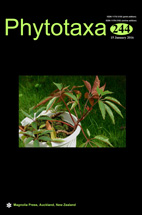Abstract
Senecio L. s.str. is the largest genus in the tribe Senecioneae (Asteraceae) and it has been commonly characterized by its truncate, penicillate stylar tips, separated stigmatic lines, and stamens usually with ecaudate anther bases and balusterform filament collar. A micromorphological study was carried out to determine if South American species of Senecio s.str. present these diagnostic micromorphological characters, as a contribution towards a circumscription of this genus supported by morphology. The study included 72 South American Senecio species from eight sections and 16 series, as well as species from six other genera of subtribe Senecioninae (Delairea, Dendrophorbium, Dendrosenecio, Graphistylis, Lomanthus, Pentacalia), three genera of subtribe Tussilagininae (Aequatorium, Nordenstamia, Roldana), and one of subtribe Brachyglottidinae (Acrisione). The studied characters include: style branches (stigmatic surface, and apices), anthers (filament collar, bases, and appendages), as well as pollen features (shape, size, and sculpture). Analyses of these characters suggested that Senecio s.str. can be defined only by the presence of balusterform filament collars, which are present in 61 out of the 72 studied Senecio s.str. species (vs. cylindrical collar in remaining species). The genera Graphistylis and Delairea also show this trait, however, Graphistylis presents some microcharacters (e.g. “banded” stigmatic surface) that are rather infrequently found in Senecio s.str. Senecio grandis showed cylindrical collars and sagittate anther bases and should be excluded from the genus. The other microcharacters analyzed appeared to be taxonomically uninformative, since their predominant states were found in Senecio s.str. as well as in other genera of Senecioneae.

